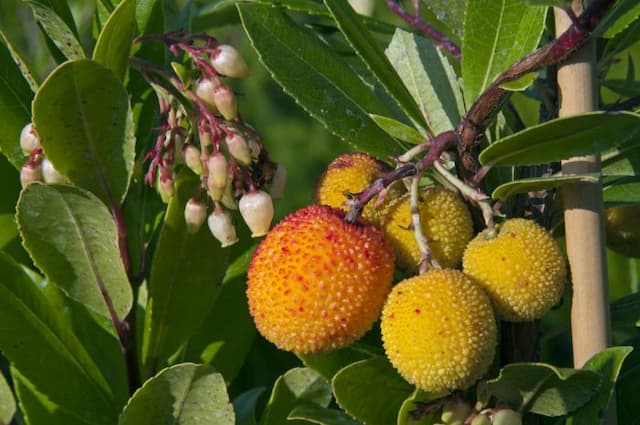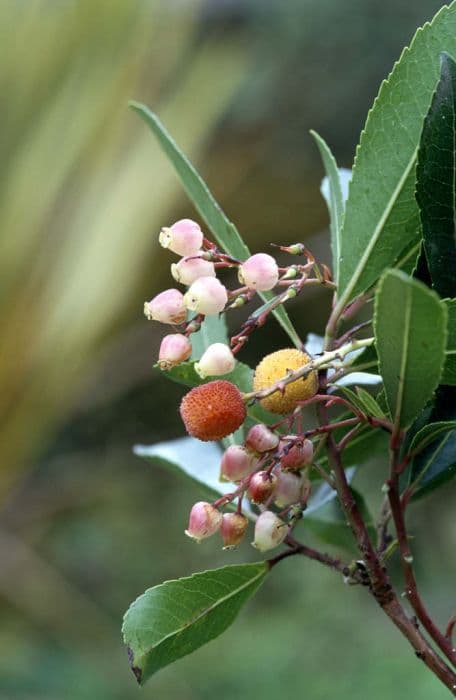Prickly Heath Gaultheria mucronata 'Crimsonia' (f)

ABOUT
The prickle-leaf, identifiable by its trademark 'Crimsonia' cultivar, is a striking plant that captures the eye with an array of features. It has glossy, evergreen foliage that provides year-round interest, with its leaves often taking on darker tones in colder conditions. The leaves are small with pointed tips, arranged densely on the stems, creating a thick and bushy appearance. The plant is especially admired for the bell-shaped flowers, which have a delicate, understated beauty. Initially white, these flowers may develop subtle pink undertones. As the seasons progress, the prickle-leaf delights with its bright red berries, which are aptly complemented by its deep green leaves, adding a pop of color that stands out in garden settings. These berries tend to persist on the plant, offering visual interest even as the cold winter approaches. This combination of shiny leaves, attractive flowers, and vibrant berries makes the prickle-leaf 'Crimsonia' a valuable addition to gardens, offering multi-seasonal appeal.
About this plant
 Names
NamesFamily
Ericaceae
Synonyms
Prickly Heath, Spiny Heath
Common names
Pernettya mucronata 'Crimsonia', Gaultheria mucronata (L.f.) Hook. & Arn. 'Crimsonia'
 Toxicity
ToxicityTo humans
The plant commonly known as Pernettya is not widely recognized as a major toxic hazard to humans. However, as with many plants not typically cultivated for consumption, it is possible that they contain compounds that can cause adverse effects if ingested. There is little documented evidence of the toxicity of Gaultheria mucronata 'Crimsonia' specifically to humans, and reports of poisoning are rare. If symptoms do occur following ingestion, they may include stomach pains, nausea, and vomiting. If any part of the plant is ingested and symptoms appear, medical attention should be sought.
To pets
Pernettya contains saponins, which can be toxic to pets if ingested in significant amounts. Symptoms of saponin poisoning in pets, particularly dogs and cats, can include vomiting, diarrhea, weakness, and stomach upset. While serious cases are rare, it is advisable to keep pets away from this plant to avoid any potential negative effects. If a pet shows signs of distress after consuming any part of the Pernettya, it is important to consult a veterinarian.
 Characteristics
CharacteristicsLife cycle
Perennials
Foliage type
Evergreen
Color of leaves
Dark green
Flower color
Pink
Height
3 feet (0.91 meters)
Spread
5 feet (1.52 meters)
Plant type
Shrub
Hardiness zones
7
Native area
Chile
Benefits
 General Benefits
General Benefits- Attractive Ornamental: Gaultheria mucronata 'Crimsonia', commonly known as the prickly heath, adds aesthetic appeal to gardens with its vivid crimson berries and glossy green leaves.
- Wildlife Habitat: Provides food and shelter for birds and other wildlife, especially during winter when food is scarce.
- Low Maintenance: Once established, prickly heath is easy to care for, requiring minimal upkeep.
- Drought Resistance: This plant is relatively drought-tolerant, making it suitable for xeriscaping and water-conserving gardens.
- Year-round Interest: Offers visual interest throughout the year with evergreen foliage, spring flowers, and vibrant autumn and winter berries.
- Erosion Control: The dense growth habit of prickly heath can help stabilize soil and prevent erosion on slopes or in areas prone to soil loss.
- Groundcover: Works well as groundcover, filling in spaces in the garden and suppressing weeds.
- Container Gardening: Suitable for pots and containers, allowing for versatile garden design and the ability to move the plants as needed.
- Adaptability: Can adapt to a range of soil types, though it prefers acidic, well-drained soil.
 Medical Properties
Medical PropertiesThis plant is not used for medical purposes.
 Air-purifying Qualities
Air-purifying QualitiesThis plant is not specifically known for air purifying qualities.
 Other Uses
Other Uses- Garden border addition: Gaultheria mucronata 'Crimsonia' can be used to create striking garden borders due to its compact growth and vivid red berries.
- Winter garden interest: Its evergreen foliage and red berries provide color and texture in the garden during the often drab winter months.
- Holiday decorations: The red berries and green foliage make attractive natural decor for winter holidays, particularly in wreaths and table arrangements.
- Fauna habitat: It provides shelter and food for birds and beneficial insects, enhancing biodiversity in the garden.
- Erosion control: Its dense growth habit can help stabilize soil on slopes or in areas prone to erosion.
- Photography subject: Its vibrant berries and foliage make it an excellent subject for nature and garden photography.
- Theme gardens: It can be incorporated into theme gardens, such as a 'winter interest' or 'wildlife-friendly' garden.
- Container planting: Suitable for growing in containers on patios or balconies where ground space is limited.
- Groundcover: Can be used as groundcover in partially shaded garden areas to suppress weeds and reduce garden maintenance.
- Edible crafting: Although not widely known for its edibility, the berries can potentially be used for decorative purposes in edible arrangements, with caution and proper identification to avoid confusion with toxic berries.
Interesting Facts
 Feng Shui
Feng ShuiThe Prickly Heath is not used in Feng Shui practice.
 Zodiac Sign Compitability
Zodiac Sign CompitabilityThe Prickly Heath is not used in astrology practice.
 Plant Symbolism
Plant Symbolism- Purity: The clean, crisp lines of the Gaultheria mucronata 'Crimsonia' often symbolize purity, much like white flowers in various cultures represent innocence and chastity.
- Protection: Some believe that prickly plants like this one, with its pointed leaves, offer protection and can ward off negative energies.
- Adaptability: Growing well in various conditions, this plant can symbolize the ability to adapt and thrive in different environments, both physically and metaphorically.
- Resilience: The Gaultheria mucronata 'Crimsonia' is a hardy plant that can withstand cold temperatures, symbolizing the strength to endure tough challenges.
 Water
WaterThe most common name for Gaultheria mucronata 'Crimsonia' is Pernettya. For watering, Pernettya prefers consistent moisture, but it's important to avoid overwatering. Water the plant when the top inch of the soil feels dry to the touch. A good approach is to water deeply and then allow the soil to partially dry before the next watering. In terms of quantity, use about half a gallon for medium-sized plants every week during the growing season, adjusting based on temperature and humidity. Reduce the frequency during the winter months when the plant is not actively growing.
 Light
LightPernettya thrives best in partial shade to full sun conditions. It benefits from some morning sunlight with protection from the harsh afternoon sun, especially in hotter climates. An ideal spot would be one that receives filtered sunlight through trees or a location with bright, indirect light to keep the foliage vibrant and support berry production.
 Temperature
TemperaturePernettya does well in a temperature range of 60°F to 75°F and can tolerate temperatures down to about 20°F without significant damage. It is a fairly hardy plant but is not well-suited to extreme heat. The ideal temperature conditions for promoting growth and berry production are between 60°F and 70°F.
 Pruning
PruningPrune Pernettya to maintain its shape and encourage bushy growth. Prune in late winter or early spring before new growth begins, removing any dead or damaged branches and thinning out crowded areas to improve air circulation. It's not typically necessary to prune annually, so every few years or as needed to control the size is usually sufficient.
 Cleaning
CleaningAs needed
 Soil
SoilThe best soil mix for Gaultheria mucronata 'Crimsonia', often known as Pernettya 'Crimsonia', is acidic, well-drained, and rich in organic matter. A blend of peat moss, sand, and pine bark creates an ideal growing medium. The plant prefers a soil pH ranging from 5.0 to 6.0.
 Repotting
RepottingPernettya 'Crimsonia' should be repotted every 2 to 3 years to replenish the soil and encourage new growth. The best time to repot is in the early spring before new growth begins.
 Humidity & Misting
Humidity & MistingPernettya 'Crimsonia' thrives in moderate to high humidity levels, between 50-70%. It will benefit from consistent humidity but is quite adaptable to average household conditions.
 Suitable locations
Suitable locationsIndoor
Keep in indirect light, maintain moist soil, and ensure high humidity.
Outdoor
Plant in partial shade, shelter from strong winds, and mulch well.
Hardiness zone
7-10 USDA
 Life cycle
Life cycleGaultheria mucronata 'Crimsonia', commonly known as prickly heath, begins its life cycle with seed germination, which requires a warm-cold stratification process to break seed dormancy. The seeds develop into young seedlings which gradually establish a root system and produce their first leaves. As the seedlings mature into juvenile plants, they begin to form the characteristic evergreen foliage and woody stems. During the flowering stage, usually in spring to early summer, white to pinkish flowers bloom, which are followed by the formation of distinctive red berries if pollination occurs. These berries persist through the fall and into winter, adding ornamental value to the plant. Over the years, the prickly heath will continue to grow and can spread through the formation of new shoots from its rhizomatous root system, slowly creating a dense thicket as it reaches its perennial mature phase.
 Propogation
PropogationPropogation time
Spring-Early Summer
Propogation: The most popular method of propagating Gaultheria mucronata 'Crimsonia', commonly known as Pernettya, is through semi-ripe cuttings. This is typically done in the late summer. To propagate, one would cut a healthy piece of stem about 4 to 6 inches (approximately 10 to 15 centimeters) long, ensuring that several leaves are left on the cutting. The lower end of the cutting is then dipped into a rooting hormone to stimulate root growth before being planted in a mixture of peat and perlite. The pot should then be covered with a plastic bag or placed in a propagator to maintain high humidity. Cuttings usually root in several weeks, at which point they can gradually be acclimated to normal conditions.









